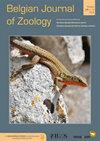螺虫四酯和阿维菌素通过暴露于猎物(Agonoscena piraciae)对捕食性甲虫(Menochilus sexmulatus)的致死和亚致死作用,对开心果果园的害虫综合管理很重要
IF 1.1
4区 生物学
Q2 ZOOLOGY
引用次数: 14
摘要
六斑叶夜蛾(Coleoptera:Coccinellidae)是开心果果园的一种重要生物防治剂,尤其是对开心果最具破坏性的害虫——白夜蛾(Agonoscena piraciae Burckhardt)和绿夜蛾(Lauterer)。在这个项目中,我们通过喂食处理过的猎物(A.piraciae),使六斑潜蝇成虫接触两种重要的常用杀虫剂,以评估对这种捕食者的副作用。我们在最大田间推荐浓度(MFRC)的2/1、1/1和1/2下测试了螺四菌素,它属于抑制昆虫脂质生物合成的酮烯醇基团,在MFRC的1/1、1/2、1/4、1/8和1/16下测试了阿维菌素,它是阿维菌素和阿维链霉菌的天然发酵产物的混合物。当通过处理过的猎物摄入三种浓度的Spirotetramat时,都不会影响六斑潜蝇的成年存活率,而与此形成鲜明对比的是,当通过处理后的猎物摄入MFRC的1/1、1/2、1/4和1/8时,阿维菌素导致六斑潜蚊100%的成年死亡率。在亚致死水平上,在所有三种测试浓度下,螺毒蛾都降低了六斑潜蝇的总繁殖力和日繁殖力,但在MFRC的1/1和1/2时不影响卵孵化。此外,当甲虫暴露于用MFRC浓度的1/1和2/1处理的猎物时,猎物的消耗量减少。使用阿维菌素,即使在MFRC的1/16时,六斑潜蝇成虫的总繁殖力、日繁殖力和猎物消耗量也会受到显著影响。总之,尽管在MFRC和较低浓度下,繁殖参数和猎物消耗会受到影响,但摄入螺四酯处理的猎物对六斑M.sexmulatus没有观察到急性毒性。与此形成鲜明对比的是,阿维菌素在其MFRC和较低浓度下的危害显著。这项研究强调了毒性风险评估的重要性,包括致命和亚致命影响,以更准确地估计当前综合虫害管理(IPM)计划中杀虫剂的兼容性。本文章由计算机程序翻译,如有差异,请以英文原文为准。
Lethal and sublethal effects of spirotetramat and abamectin on predatory beetles (Menochilus sexmaculatus) via prey (Agonoscena pistaciae) exposure, important for integrated pest management in pistachio orchards
Menochilus sexmaculatus Fabricius (Coleoptera: Coccinellidae) is an important biological control agent in pistachio orchards, especially against Agonoscena pistaciae Burckhardt and Lauterer (Hemiptera: Psyllidae), which is the most damaging pest of pistachio. In this project we exposed M. sexmaculatus adults to two important commonly-used insecticides through feeding on treated prey ( A. pistaciae ) to evaluate the side-effects on this predator. We tested spirotetramat, which belongs to the keto-enol group inhibiting lipid biosynthesis in insects, at 2/1, 1/1 and 1/2 of the maximum field recommended concentration (MFRC), and abamectin, which is a mixture of avermectins and a natural fermentation product of the bacterium Streptomyces avermitilis , at 1/1, 1/2, 1/4, 1/8 and 1/16 of its MFRC. Spirotetramat did not affect adult survival of M. sexmaculatus at all three concentrations when ingested via treated prey, while in marked contrast abamectin caused 100% adult mortality of M. sexmaculatus when ingested via treated prey at 1/1, 1/2, 1/4 and 1/8 of the MFRC. At sublethal levels, spirotetramat reduced total and daily fecundity of M. sexmaculatus at all three concentrations tested, but did not affect egg hatching at 1/1 and 1/2 of the MFRC. Moreover, prey consumption was decreased when beetles were exposed to the prey treated with spirotetramat at 1/1 and 2/1 of the MFRC concentrations. With abamectin, even at 1/16 of the MFRC, total fecundity, daily fecundity and prey consumption of M. sexmaculatus adults were significantly affected. In conclusion, no acute toxicity was observed on M. sexmaculatus by ingestion of prey treated with spirotetramat, although reproduction parameters and prey consumption were affected at MFRC and lower concentrations. In marked contrast, abamectin was notably very harmful at its MFRC and also at lower concentrations. This research highlighted the importance of toxicity risk assessments, including lethal and sublethal effects, to obtain a more accurate estimation of the compatibility of insecticides in current integrated pest management (IPM) programs.
求助全文
通过发布文献求助,成功后即可免费获取论文全文。
去求助
来源期刊

Belgian Journal of Zoology
生物-动物学
CiteScore
1.90
自引率
0.00%
发文量
10
审稿时长
>12 weeks
期刊介绍:
The Belgian Journal of Zoology is an open access journal publishing high-quality research papers in English that are original, of broad interest and hypothesis-driven. Manuscripts on all aspects of zoology are considered, including anatomy, behaviour, developmental biology, ecology, evolution, genetics, genomics and physiology. Manuscripts on veterinary topics are outside of the journal’s scope. The Belgian Journal of Zoology also welcomes reviews, especially from complex or poorly understood research fields in zoology. The Belgian Journal of Zoology does no longer publish purely taxonomic papers. Surveys and reports on novel or invasive animal species for Belgium are considered only if sufficient new biological or biogeographic information is included.
 求助内容:
求助内容: 应助结果提醒方式:
应助结果提醒方式:


